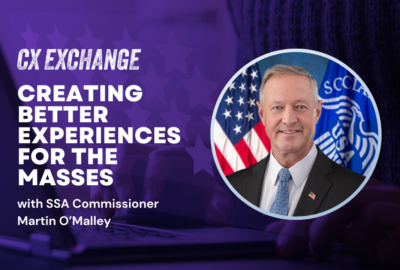Hubbard Radio Washington DC, LLC. All rights reserved. This website is not intended for users located within the European Economic Area.
CX Exchange 2024: VA’s John Boerstler on expanding outreach to veterans
VA’s chief veterans experience officer explains how the department reaches out to service members transitioning back to civilian life.
What’s the Department of Veterans Affairs’ most important metric for measuring customer experience? Showing improvement.
That’s the most basic must-do, said the department’s Chief Veterans Experience Officer John Boerstler.
VA recently announced veteran trust in outpatient care increased to nearly 92% — a 6% improvement from when the department first began gathering this data in 2018. The department gathered feedback from 480,000 veterans who recently received VA health care.
Those improved metrics reflect the hard work of VA employees, many of whom are veterans themselves, Boerstler said during Federal News Network’s CX Exchange 2024.
“Training them how to deliver a world-class customer experience has really been where the rubber meets the road,” he said. “You can’t have a world-class customer experience without a world-class employee experience. Arming our employees with better training and better tools and better data, so that they can properly engage those veterans and their families and deliver that world-class experience, has been really impactful for us.”
While VA continues to improve the experience of veterans already enrolled in its care and benefits, Boerstler said the department is trying to “readjust its customer acquisition funnel” and reach both service members who are transitioning back to civilian life as well as veterans who have never enrolled in VA health care or benefits programs.
“Government really doesn’t think about how we might acquire more customers and ensure that we’re delivering a great experience. What pain points, bright spots, and moments that matter, along the individual veteran journey, are most important that we can really focus on?” Boerstler said.
Transitioning from service member to veteran
Under the Biden administration, VA has focused on improving the experience of transitioning service members as one of five priority “life experiences” across the federal government.
“That’s our first opportunity to really wow them, to really delight them, to really ensure that they have a successful reintegration from military to civilian life,” Boerstler said. “And in many ways, we’re designing for that persona — or multiple personas, as we discovered, after interviewing hundreds of transitioning service members, recently separated veterans and their family members.”
Based on that feedback, VA has developed several personas to better understand the needs and preferences of the latest generations of veterans.
“We’re better understanding what their pain points are along that journey. Namely, that we have to think about it from a generational lens. Most of the active-duty military force — all six service branches and enterprise Defense Department — they’re Millennials and Gen Z, that are raising their right hand and swearing in to protect and defend the Constitution of the United States. And a lot of our course materials and our curriculum, what we found was that didn’t really resonate with those generations.”
Boerstler said VA is developing a minimum viable product that will serve as a “digital checklist” of its benefits that service members can sign up for during their military service and as they prepare to return to civilian life. With Millennials and Gen Z in mind, VA teams are developing and designing that checklist as digital-first and mobile-friendly.
“They want it in the palm of their hands. They want it mobile-friendly. They want push notifications. They want to enroll. They want to test things out,” Boerstler said. “And so we’re going to build an ecosystem where they can do all those things and enroll in benefits and care that they have so rightly earned.”
VA expects to have a minimum viable product ready to test this summer, with a launch in fall 2024.
“It’ll allow them to enroll into a digital experience right after they finish their training school, at the beginning of their service, so that they’re able to then understand exactly what they need, and when they need to pursue, based on their expiration of term of service (EAS) date. Then we’ll send them pushes along that journey when they’re eligible,” he said.
Boerstler said this new online tool will remind active-duty military service members that they are eligible to receive VA home loans, calls from the Veteran Crisis Line, if they need to. They’re also eligible to go to any of VA’s 300 Vet Centers for family counseling or mental health counseling, or to participate in a peer support group
“As they get closer to that 12 months prior to separation, and then even that six months prior to separation, they’re allowed to file a disability claim. They’re allowed to start exploring their GI Bill education benefits,” Boerstler said. “They’re allowed to do so many other things, but just making them more aware and personalizing it, based on exactly what their priorities are, when they are planning to leave the military — whether that’s going to school, whether it’s getting a new job, whether that’s relocating their family. There’s so much we could be doing to really improve this customer experience.”
VA also wants to make its Transition Assistance Program a more immersive experience for new veterans and individuals leaving military service.
“Almost every individual we spoke with who was either in the process of separating from the military or had recently separated from the military, said, ‘I wish I had known about this benefit or this program earlier. I wish that I could have engaged. I wish that my spouse could have attended the course with me. I wish that I had started the Transition Assistance Program pathway at the right time,’ ” he said.
Service members must start the TAP program at least one year before leaving service, but Boerstler said VA has begun to “rethink and redesign this experience,” to reflect the preferences of new incoming veterans.
Starting a ‘lifelong relationship’ with VA
The department now delivers more care and more benefits to more veterans than at any point in its history. Much of this has to do with the PACT Act, which expands the eligibility of VA care and benefits to veterans exposed to toxic substances during their military service. Under the law, VA must reach out to millions of toxic-exposed veterans to inform them of the benefits and care that they’re now eligible to receive.
VA still contacts veterans through postal mail, but it also sends hundreds of thousands of emails every week to let different cohorts of veterans know about their eligibility through specific, tailored content that aims to resonate with them.
“When somebody sends you a letter from the government or a postcard tip, people tend to open it up, which is great. But how do we open other channels of communication, namely email, and now text messages?” Boerstler said.
“They can always opt out of both email and text message of course, but I think it’s just an incredible opportunity to communicate with veterans in new and innovative ways.”
VA, for example, recently sent an email to hundreds of thousands of Vietnam veterans who are now eligible to enroll in VA health care under the PACT Act. Following that email campaign, 1,800 Vietnam veterans who had never enrolled in health care with the department signed up.
Boerstler said VA also recently sent out hundreds of thousands of emails to Afghanistan and Iraq war veterans with specifically tailored content to make them aware of those benefits too. He said these email campaigns are part of VA’s full-court press to “start a lifelong relationship” with veterans who’ve never engaged with VA for care and benefits services before.
“For the first time, we’re using outbound text messaging as a tool to really say, ‘Hey, did you know that you might be eligible for VA benefits and care. Call us at 1-800-MyVA411, our telephonic front door, or visit us online at Va.gov/PACT, our digital front door, and we’d love to start a lifelong relationship with you,’” Boerstler said.
Discover more customer experience tactics and takeaways from Federal News Network’s CX Exchange 2024 now.
Copyright © 2024 Federal News Network. All rights reserved. This website is not intended for users located within the European Economic Area.
Jory Heckman
Jory Heckman is a reporter at Federal News Network covering U.S. Postal Service, IRS, big data and technology issues.
Follow @jheckmanWFED





